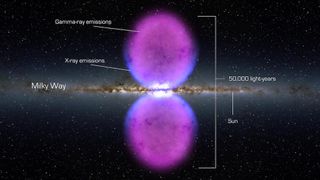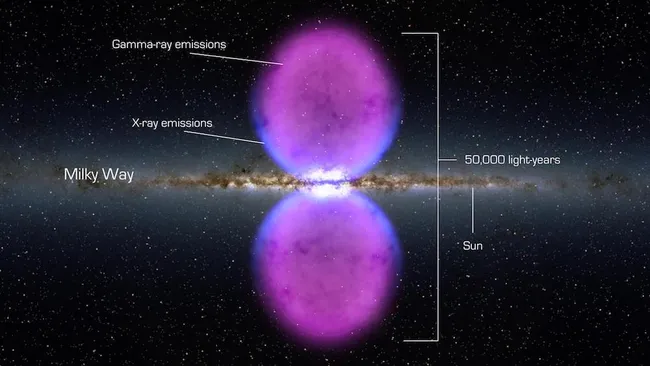The most energetic particles in the universe appear to emerge from sources within the Milky Way, our home galaxy.
Cosmic rays are made of subatomic particles, such as protons and electrons, whose energies span a wide spectrum. Ultra-high-energy cosmic rays easily host tens of millions of times more energy than any particle accelerator can generate on Earth, but where they come from — and precisely what accelerates them to become some of the fastest in the universe — has intrigued scientists since the discovery of these phenomena in 1962.
In the past, astronomers had managed to provide some solid evidence that cosmic rays come from sources residing outside the Milky Way. But now, a new study suggests they also originate from within the galaxy, blasting out from the leftovers of exploded stars, otherwise known as supernova remnants.
The new observations “open the tantalizing possibility that matter from a particular nearby supernova remnant can be measured at Earth,” study co-author Gregory Guzik of the Louisiana State University said in a statement.
High-energy cosmic rays may originate within the Milky Way galaxy

The Fermi bubbles are believed to be two enormous orbs of gas and cosmic rays that tower over the Milky Way. (Image credit: NASA Goddard)
The most energetic particles in the universe appear to emerge from sources within the Milky Way, our home galaxy.
Cosmic rays are made of subatomic particles, such as protons and electrons, whose energies span a wide spectrum. Ultra-high-energy cosmic rays easily host tens of millions of times more energy than any particle accelerator can generate on Earth, but where they come from — and precisely what accelerates them to become some of the fastest in the universe — has intrigued scientists since the discovery of these phenomena in 1962.
In the past, astronomers had managed to provide some solid evidence that cosmic rays come from sources residing outside the Milky Way. But now, a new study suggests they also originate from within the galaxy, blasting out from the leftovers of exploded stars, otherwise known as supernova remnants.
The new observations “open the tantalizing possibility that matter from a particular nearby supernova remnant can be measured at Earth,” study co-author Gregory Guzik of the Louisiana State University said in a statement.
Related: Earthquakes seem more intense after cosmic ray strikes. Scientists say this is why
The latest results are thanks to a sensitive, dedicated telescope mounted outside the International Space Station (ISS), which since 2015 has been struck by over seven million ultra-high-energy cosmic ray particles. The instrument, the Calorimetric Electron Telescope (or CALET), was installed on the ISS with the hopes of being a more powerful cosmic ray detector than its flagship predecessor, the Alpha Magnetic Spectrometer.
Cosmic rays are known to rapidly lose energy once they exit their sources, so scientists say the recorded high-energy rays are convincing evidence that they originated from sources nearby our solar system.
But where exactly are they coming from? The team does not know for sure yet, but have some suspicions.
It’s possible, the researchers say, that the rays emerged from at least three of 12 supernova remnants scattered around our solar system within 3,000 light-years of us. One of them could be Vela, at a little over 800 light-years away. Vela is an 11,000-year-old, well-studied remnant of an exploded star, which shone 250 times brighter than Venus when it blasted and would have been visible as a bright flash in the sky even during the daytime. This remnant is also associated with the Vela pulsar — a rapidly rotating neutron star that broke records this year, when it released the highest-energy radiation ever seen coming from its kind.

They “give insight into what’s going on in these supernova remnants, and offer a way to understand the galaxy and these sources in the galaxy better,” Cannady added.
The CALET telescope recorded its first event in October 2015. Among the seven million rays detected since then, the telescope was able to identify a range of cosmic ray energies, all the way up to levels of 10 teravolts, with a few even beyond. This is a significant step up from previous works, which could only detect cosmic rays at about 4 teravolts, the scientists say.
“This is essentially what CALET was put up to do,” Cannady said. “So it’s exciting to be working on this and to finally be getting results that are pushing the bounds of what we’ve seen before.”
The team plans to continue CALET measurements of cosmic ray sources until the ISS retires, which will likely be by the end of this decade.
Credit: Space.com



